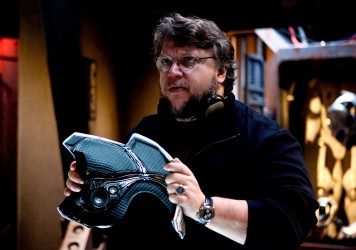Guillermo del Toro’s epic homage to classic-era monster movies is a triumph of consummate design and old school romanticism.
Guillermo del Toro’s rousing response to the 2011 Tōhoku earthquake and subsequent Fukushima Daiichi nuclear disaster involves oversized reptilian day-glo hell-beasts tearing apart major world capitals like they’re engaged in some unfortunate metropolitan trolley dash. Unlike the large majority of silver screen alien lifeforms, these monsters – dubbed Kaijus by Earth’s withered populous – are fertilising underneath the ocean bed and rising up, each one bigger and stronger than the last and at exponentially shorter intervals, to wreak their apparently motiveless project of total destruction.
Thankfully, good ol’ German engineering is here save the day, and a phalanx of nuclear-powered, steampunk battle robots are produced as a lifeline for the planet. These machines are named Jaegers, and they can only be operated by two human pilots whose minds are cross-hatched to bear the psychological load. Sibling and parent-child configurations prove the most compatible, though del Toro – the old romantic – adopts this device as a catalyst for a love story. All of this is explained in the space of about four minutes in a masterful piece of introductory montage.
Del Toro hinted at Pacific Rim’s epic-scale mayhem during a sequence in Hellboy II in which Ron Perlman’s noir-styled devil defender took on a giant (and irate) squid in the middle of a busy boulevard. He hinted that he had the chops to marshal these kind of grand digital bouts and grapple with the intricate choreography it takes to make an audience understand and enjoy them. He never hinted, though, that he had it in him to produce action sequences so majestic and graceful, a rock-’em, sock-’em urban ballet with a trillion-dollar fallout.
Unlike the Transformers movies in which the geography and basic logic of the metal-on-metal pugilism fell between the cracks of the ADD editing and camera movements which mimicked a particularly frantic hummingbird, del Toro has total faith in his images. He lets them do the heavy lifting, not the technique. He has fun, too, transporting us within a matter of frames between the macro to the micro, from a devastated city battleground to a flock of resting seagulls being prodded from their perch by the hulking boot of a skidding Jaeger. We also take a brief time out from a Hong Kong tear-up to follow a Jaeger’s fist through an office block, right up to a miniature homage to Sir Isaac Newton.
As you’d except from this literary fabulist and ardent cinephile, the design of the film is quite breathtaking, and the simplicity of the narrative feels like it could’ve been ripped from the classical era. On its most basic level, Pacific Rim operates as a literal and thematic paean to Ishirō Honda’s 1954 original-and-best Godzilla, as much a cautionary tale about the misuse of nuclear materials (“water’s flooding into the reactor core!” screams one unfortunate (Russian!) Jaeger pilot prior to death) as it is a truly wondrous piece of high-tension comic book hokum.
The film is also in thrall to the wonders of technology, specifically the clever fusion of the analogue and the digital and its world-creating, world-saving and world-destroying capabilities. From the heavy proliferation of pistons, flywheels and giant whirring cogs (all del Toro staples) in its early exposition scenes to its overall affirmation that human engineering can be used to achieve against-the-odds marvels, the film is that rare thing: a blockbuster in which all traces of cynicism and snark have been expunged in favour of a doe-eyed sincerity which roots the film – surely as its director intended – deep into the classical era.
And don’t be put off by the film’s dearth of “movie stars”. Charlie Hunnam and Rinko Kikuchi make for a charming central pairing, both mentally-damaged Jaeger pilots whose thirst for revenge threatens to cloud their responsibility to save the planet, and their burgeoning love for one another. Del Toro is also a master of tragic hardmen, and he comes up trumps again with Idris Elba’s Eastwood-like leader of the Earth’s defence, desperate to get out into the field but hampered by an affliction from his glory days. The performances a big and broad, maybe even clunky to the eye not covered with auteurist spectacles. But the actors are clearly self-aware, working perfectly within the context of this story and del Toro’s own framework of literary references and old school archetypes.
One problem with Pacific Rim, and it’s a problem endemic with studio disaster movies tailored to appeal to broad and multi-generational audiences, is that cities are razed and the screen death toll barely rises into double figures. On the evidence of a film like Pan’s Labyrinth, del Toro is clearly not a director averse to stuffing and mounting the bloody cadavers of those affected by violent social unrest, so what’s his motive behind Pacific Rim’s largely bloodless coup? Perhaps these kind of films are only economically viable with the taboo of mass death handily swept under the carpet. In this consumerist age, it’s the buildings that we’re supposed to care about, their annihilation standing in for a human body count.
Sure, there are a couple of plot holes in the set-up and the mechanics of the Kaiju’s lair are improbably complex, but this is such a visual and sensual treat that you’d be churlish to dwell on these very minor defects. Pacific Rim is easily del Toro’s most mainstream offering to date, but it may also be his most fully satisfying, with all of his esoteric tics and concerns safely stowed away in the sizable head of his hulking mecha-gods.
Published 11 Jul 2013
“Tracking” (whatever that is) has apparently been worrying the nabobs on this one.
Rich, romantic and always politically motivated. This is a model blockbuster.
Great in and of itself, but also in terms of showing up a lot of similarly-inclined destructo-porn movies.

By Poppy Doran
The Crimson Peak director has teamed up with Sally Hawkins and Michael Shannon for a Cold War-set fantasy romance.

The great Guillermo del Toro talks about his magnificent Gothic ghost story.

Twelve writers pin their colours to the tentpole in our survey of the best summer movies of the modern era.